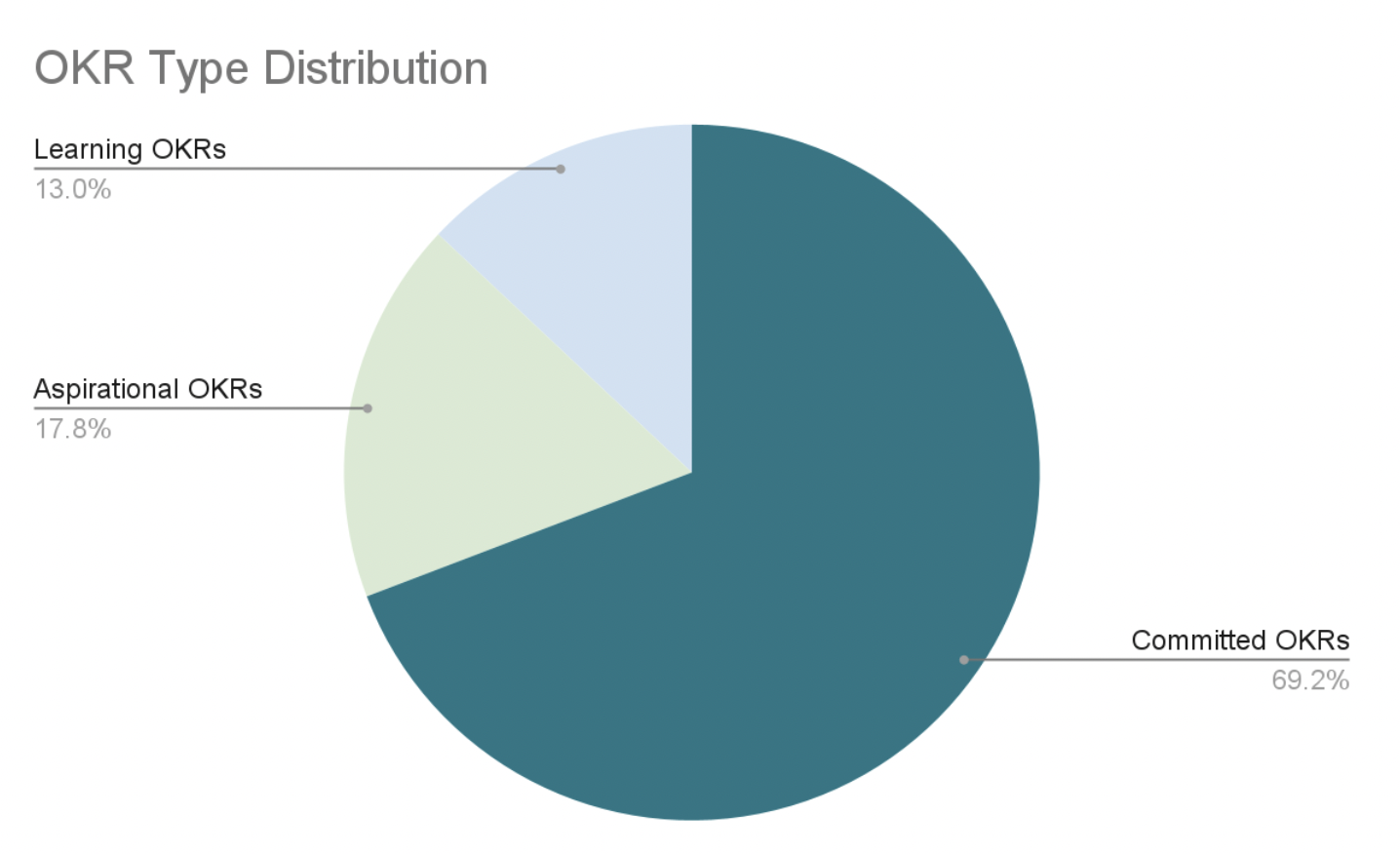How do some startups hit $1M ARR faster - while others stall before they get there?
According to our research, founders who introduced a clear goal system early were significantly more likely to reach the $1M ARR milestone faster - not because they set better goals, but because they built better systems.
Every startup reaches a stage where good ideas aren’t enough.
The pace of execution outgrows the systems holding it together. What used to be clear in conversation starts slipping through the cracks - priorities drift, updates get lost, and everyone seems busy, but not necessarily aligned.
That’s the point where structure starts to matter - and Objectives and Key Results (OKRs) make sense.
OKRs are not just a goal-setting framework - they’re a rhythm for focus and accountability. The best teams use OKRs to translate ambition into measurable outcomes and ensure every team, from engineering to marketing, pulls in the same direction.
Our Startup OKR research across 200 startups revealed a clear pattern:
- Teams that adopt OKRs early often reach key revenue milestones faster
- 39% see measurable impact within the first 90 days
- 89% say they wish they’d started sooner
OKRs work - but only when the system does.
What Are OKRs?
OKRs stand for Objectives and Key Results - a simple but powerful framework for setting, tracking, and achieving goals.
- Objectives define what you want to achieve. They should be clear, inspiring, and time-bound.
- Key Results define how you’ll measure success. They’re specific, measurable outcomes that track progress toward your objective.
For example:
This simple pairing helps teams move from vague goals (“make things better”) to concrete progress (“reduce errors by 75%”).
The Three Types of OKRs
Not all OKRs serve the same purpose.
In practice, high-performing teams use three distinct types of OKRs, depending on the level of certainty and ambition involved:
- Committed OKRs. Outcomes the team expects to fully deliver. These are based on stable baselines and predictable work.
- Aspirational OKRs. Stretch goals designed to push performance beyond the current trajectory. Partial success is expected.
- Learning OKRs. Goals focused on discovery — validating assumptions, testing levers, and reducing uncertainty before committing to outcomes.
The mistake most teams make isn’t writing poor OKRs - it’s using the wrong type of OKR for the situation. We’ll explore this in more detail later, using real startup data.
Brief History of OKRs
Most people first hear about OKRs through Google - but the framework is older, simpler, and far more startup-friendly than most realize.
Its roots go back to the 1970s at Intel, when Andy Grove introduced a new way for teams to set goals with clarity, accountability, and focus. Instead of handing out long planning documents, Grove pushed teams to answer two questions:
What do we need to achieve?
And how will we measure progress?
When John Doerr brought OKRs to Google in 1999, the company had fewer than 40 employees. They needed a way to stay focused while growing at impossible speed. OKRs gave them that structure — a system that was lightweight enough for a startup, but powerful enough to scale into one of the world’s most complex organizations.
Since then, OKRs have become the default operating system for high-growth teams. Not because they are trendy, but because they solve a universal problem: how to stay aligned and accountable when everything is moving fast.
Below is the original OKR presentation John Doerr gave to Google’s founding team - the moment OKRs entered the modern startup world.
The Difference Between OKRs and KPIs
Before diving into the strategy, it’s important to clarify what OKRs are not.
Many teams confuse OKRs with KPIs, but the two serve different purposes. — and mixing them is one of the most common failure patterns we see.
In fact, our own research found that 52% of all Key Results written are actually KPIs in disguise: metrics teams already track, rather than outcomes they intend to change.
KPIs (Key Performance Indicators) measure the health of ongoing operations. They tell you if your engine is running smoothly - conversion rate, uptime, churn, or revenue per user. KPIs are stable and continuous.
OKRs, on the other hand, define change. They set direction and focus for what you’re trying to improve, build, or transform over a set period - usually a quarter. While KPIs keep you accountable for performance, OKRs push you toward progress.
Think of it like this:
- KPI = “Keep the system running.”
- OKR = “Change the system for the better.”
Successful organizations use both. KPIs sustain; OKRs evolve.
Where Startups Go Wrong With OKRs
Once teams understand what OKRs are - and how they differ from KPIs - a new challenge emerges: using the right kind of OKR at the right time.
When we analyzed live OKRs across early-stage startups, a clear pattern appeared in how teams structure their goals and found that most teams overcommit and underinvest in learning:

This imbalance explains many of the frustrations teams experience with OKRs.
Most startups default heavily toward committed OKRs — treating nearly every goal as a must-deliver outcome - even in situations where uncertainty is still high. As a result:
- Teams commit to outcomes before fully understanding the levers
- Stretch goals are framed as guarantees, damaging trust when they’re missed
- Learning happens informally, without clear ownership or accountability
OKRs don’t fail because teams lack discipline or ambition. They fail because teams apply a single goal type to every situation.
High-performing startups deliberately balance execution (committed), acceleration (aspirational), and discovery (learning). In the sections that follow, we’ll show how to design OKRs that match intent — and how to build a system that actually works in practice.
How Important Are OKRs for Growth?
In fast-growing startups, focus is the first thing to break. Teams move fast, but not always together. OKRs solve that alignment gap.
Research shows that companies using structured OKRs grow faster and more sustainably:
- Startups with clear OKRs are 68% more likely to hit early revenue milestones.
- Teams that assign ownership see 26% higher completion rates.
- Those who launch OKRs in under a week achieve up to 50% more success.
OKRs give growing companies a shared language for progress. They connect goals to execution, effort to outcomes, and people to purpose.

7 Ways to Get Started with OKRs
Designing OKRs that actually work requires more than enthusiasm or templates. It demands structure, alignment, and a rhythm your team can sustain.
These seven principles form the foundation of every high-performing OKR system - practical, repeatable, and proven across hundreds of startup teams.
Let’s dive in.
1. Start With Strategy, Not Spreadsheets
Many teams begin their OKR journey by downloading a spreadsheet or copying someone else’s structure. The result? A list of goals that look impressive but lack context.
A strong OKR strategy starts with clarity - not tools. Before you write a single Objective, answer three questions:
- What is our company’s primary goal for the next quarter or year?
- What are the biggest levers that move us closer to it?
- How do we measure success in a way that drives behavior, not bureaucracy?
Startups that skip this step often find themselves tracking “busy metrics” instead of strategic outcomes. A great OKR doesn’t describe what you’re doing - it defines why it matters.
When goals are rooted in strategy, OKRs become more than numbers; they become alignment tools.
2. Get Everyone Pulling in the Same Direction
One of the biggest mistakes teams make is setting OKRs in isolation. Marketing sets their goals, product sets theirs, and suddenly you have five directions competing for attention.
Alignment means making sure every team’s objectives ladder up to the company’s core priorities.
In fact, 65% of teams admit their OKRs aren’t tied to company goals - and it shows. Misaligned OKRs create friction, duplicated effort, and missed opportunities.
The most successful teams build “stacked OKRs.” That means:
- Company OKRs define the strategic north star.
- Department OKRs interpret how each function contributes.
- Individual OKRs connect to specific outcomes that move those goals forward.
When everyone can see how their work connects to the mission, ownership becomes natural and motivation follows.
3. Keep It Simple - Fewer Goals, Bigger Impact
Complexity kills momentum.
High-performing startups rarely manage dozens of OKRs - they focus on a handful that truly matter. Teams with just 1–2 OKRs per quarter are twice as likely to achieve them as those juggling three or more.

Every Objective should be clear, measurable, and actionable. Every Key Result should describe an outcome, not a task.
- ❌ “Launch new onboarding flow”
- ✅ “Increase activation rate from 22% to 35% by end of Q3”
The simpler the structure, the stronger the focus. When teams chase fewer goals, they achieve more of them - and with greater impact.
4. Measure What Matters, Not Just What’s Done
Activity-based goals feel good but don’t always move the business forward.
Strong OKRs define success in measurable terms. They’re grounded in data, not intentions. For example:
- Instead of “Improve user engagement,” try “Increase weekly active users from 40% to 55%.”
- Instead of “Enhance reliability,” try “Reduce downtime from 3.5% to under 1%.”
From our OKR Benchmark report, teams that assigned clear metrics to every Key Result achieved 26% higher completion rates. Measurable goals create accountability and eliminate ambiguity.
Numbers don’t just track progress - they tell stories. They reveal what’s working, what’s not, and where to focus next.
5. Build a Weekly Rhythm That Sticks
OKRs fail when they’re treated as quarterly events instead of ongoing systems.
In startups that consistently achieve their goals, OKRs are built into the rhythm of work. They show up in sprint planning, team reviews, and Monday meetings.
Why does this matter? Teams that check in weekly complete 43% more OKRs than those that review them monthly or sporadically.

A great OKR system doesn’t add meetings - it creates focus. It’s about visibility, not volume. Everyone should know where progress stands without digging through five tools or chasing updates.
This rhythm also prevents the “set-and-forget” problem. When goals are visible every week, they stay alive.
6. Build a Learning Loop Into Every Cycle
Every OKR cycle ends with a choice: move on, or learn and improve.
Use it to learn. Teams that skip retrospectives complete 30–45% fewer OKRs in their next cycle. Reflection turns OKRs from a performance system into a learning system.
Ask questions like:
- What worked?
- What didn’t - and why?
- Which goals were too ambitious, and which were too safe?
- What habits should we carry forward next quarter?
Mature OKR teams use retros to refine - not restart - their systems. They don’t reinvent the process every time; they evolve it.
This habit compounds over time. By the fifth OKR cycle, teams are 20% more likely to hit their goals compared to those just starting out.

7. Choose Tools That Help, Not Hinder
Simple tools work at first - but as teams grow, visibility and accountability get lost.
When we spoke with 200+ startups, 56% of startups said they begin with Google Sheets before moving to OKR software. The shift isn’t about features; it’s about consistency.
As teams grow, manual updates and siloed docs slow everything down. A dedicated OKR platform - like OKRs Tool - helps teams:
- Track progress automatically
- Assign ownership
- Visualize alignment between company and team goals
- Keep everyone accountable without constant chasing
That doesn’t mean you need enterprise software. Lightweight, async-friendly tools work best for small, fast-moving teams.
The goal isn’t to manage OKRs - it’s to make them part of how you work.
Bringing It All Together
Building a great OKR strategy isn’t about mastering a framework - it’s about creating a culture of focus and follow-through. When teams stay aligned, measure what matters, and learn every quarter, growth becomes consistent, not chaotic.
Here’s a quick summary of the seven pillars of successful OKRs:
Together, these steps form the backbone of a sustainable OKR process - one that grows with your team and keeps focus sharp, no matter how fast things move.
Final Thoughts
OKRs aren’t just another management trend - they’re a framework for focus, accountability, and progress. When designed well, they help startups turn chaos into clarity and ambition into measurable momentum.
The secret isn’t in writing perfect goals. It’s in building habits around them. The best OKR strategies don’t live in slides or spreadsheets; they live in the rhythm of weekly conversations, visible dashboards, and small, consistent wins.
Every team has ambition. The difference between those who scale and those who stall is execution. Teams that align, measure, and reflect every quarter build a culture of follow-through - one where goals don’t fade, they compound.
So as you design your OKR strategy, start simple, stay consistent, and remember this: great teams don’t just set goals - they run them.






